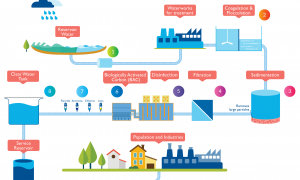🕑 Reading time: 1 minute
Precipitation is the process by which all forms of water reach back to earth from the atmosphere. Precipitation occurs in the form of rainfall, frost, hail, and dew. Among all, rainfall and snowfall contribute a significant amount of water.
In water resource study, precipitation is commonly considered as rainfall, as it is one of the major sources of water coming to earth. The forms, types, and features of precipitation are briefly explained below.
Contents:
Forms of Precipitation
The major forms of precipitation are :
1. Rain
Rain is a form of precipitation that is in the form of water drops of a size larger than 0.5mm. The maximum raindrop size is about 6mm. Drops of larger size break up into smaller drops as it falls down.
Rainfall is the predominant form of precipitation and hence the term precipitation is used synonymously with rainfall. The magnitude of rainfall shows high temporal and spatial variation. This variation is responsible for the occurrence of hydrologic extremes such as floods and droughts.
2. Snow
Snow consists of ice crystals in a flaky form (average density ~ 0.1g/cc). It is also an important form of precipitation.
3. Drizzle
Drizzle is a fine sprinkle of tiny water droplets of size less than 0.5mm and intensity greater than 1mm/h. The tiny drops forming a drizzle appear to float in the air.
4. Glaze (Freezing Rain)
The glaze is formed when rain or drizzle comes in contact with the cold ground at around 0 degrees celsius. The water drops freeze to form an ice coating.
5. Sleet
Sleet is frozen raindrops formed when rainfall passes through the air at subfreezing temperatures.
6. Hail
Hail is a type of showery precipitation in the form of pellets or lumps of size greater than 8mm. Hail occurs in violent thunderstorms.
Types of Precipitation
Precipitation occurs when the moist air mass undergoes condensation. This process happens when the air is cooled and saturated with the same amount of moisture. This process of cooling air mass is performed only when the air mass moves up to higher altitudes. The air mass can be lifted to higher altitudes mainly by three methods based on which there are three types of precipitation namely:
- Cyclonic Precipitation
- Convective Precipitation
- Orographic Precipitation
1. Cyclonic Precipitation
A cyclone is a region in the atmosphere with large low pressure having circular wind motion. The cyclonic precipitation is caused by the movement of moist air mass to this region due to the difference in pressure. Cyclones can be of two types frontal and non-frontal precipitation.
Frontal Precipitation
A frontal is called as the hot moist air mass boundary. This precipitation is caused by the expansion of air near the frontal surface.
Non-Frontal Precipitation
This is a cold moist air mass boundary that moves and results in precipitation.
2. Convective Precipitation
The air above the land area gets heated up by some cause. The most warmer air rises up and cools and precipitates. Convective precipitation is showery in nature. This type of precipitation happens in varying intensities. The areal extent of convective precipitation is small in the range of less than 10km in diameter.
3. Orographic Precipitation
Moving air masses have chances to strike barriers like mountains. Once they strike, they rise up which causes condensation and precipitation. The precipitation is greater in the windward side of the barrier compared to the leeward side of the barrier.
The table below shows the types of rainfall based on their intensity
| Type of Rainfall | Intensity (mm/h) |
| Light | Trace to 2.5 |
| Moderate | 2.5 - 7.5 |
| Heavy | >7.5 |
Occurrence of Precipitation
Precipitation occurs when the atmosphere has sufficient moisture. There must be sufficient nuclei (salt particles, products of combustion, etc) in the atmosphere to make condensation happen. Weather conditions must be favorable for the condensation of water vapor to take place.
Under favorable weather conditions, water vapor condenses over these nuclei to form tiny water droplets of size (generally less than 0.1mm in diameter). The clouds are carried by the wind while its turbulence helps to retain water droplets in suspension (similar to particles in a colloidal suspension).
Precipitation occurs when these water droplets come together and coalesce, forming larger drops of water that can dropdown. When the precipitation occurs, a considerable part of it evaporates back into the atmosphere.
Net precipitation at a place and its form depend on a number of meteorological factors such as temperature, humidity, wind, pressure in the region.
Also Read: What is Hydrology Cycle?


